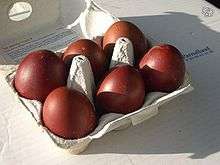Marans
|
A Cuckoo Marans hen | |
| Other names |
|
|---|---|
| Country of origin | France |
| Standard | Marans-Club de France (in French) |
| Traits | |
| Weight |
Male: Standard: 3.5–4 kg Bantam: 1100 g[1] |
|
Female: Standard: 2.5–3 kg Bantam: 900 g | |
| Egg color | Dark brown |
| Comb type | Single |
| Classification | |
| APA | Continental[2] |
| PCGB | Soft Feather: Heavy[3] |
|
Chicken Gallus gallus domesticus | |
The Marans, French: Poule de Marans, is a breed of chicken from the port town of Marans, in the département of Charente-Maritime, in the Poitou-Charentes region of western France. It was created with the local feral chickens descended from fighting game chickens carried from Indonesia and India. Those original Marandaise fowl were "improved" for the table through recombination with imported Croad Langshans. A favourite at poultry shows, it is a dual purpose fowl known both for its extremely dark eggs and fine meat qualities.
History
The Marans originated in Marans, France, and were imported into the United Kingdom in the 1930s.
Appearance
There are 9 recognized colours in the French Standard: Cuckoo, Golden Cuckoo, Black, Birchen, Black Copper, Wheaten, Black-tailed Buff, White and Columbian. Black Copper (black with copper feathers on the neck) and Cuckoo (barred feathers, giving a black and white speckled appearance) are the most common of these. Other colors not officially recognized (such as Blue Copper, Blue, and Splash) also exist.
They should have orange eyes. The shanks are usually slate or pink, the soles of the feet should always be white as Marans have white skin, not yellow. Though the original Marans could also be feather legged birds, British breeders preferred the clean legged version, and thus feathered legged Marans are now mainly found in France and the United States. The Australian Poultry Standard recognises both feathered and clean-legged.[4] The American Poultry Association only recognizes feathered legged.
Characteristics

Marans are generally quiet and docile; but they are quite active, taking well to free ranging in rough terrain and are also tough and disease-resistant. Their gentle temperaments and quiet demeanor makes them ideal for suburban backyard chicken keepers, as well as any assorted farm flock as they rarely bully smaller breeds.
Marans lay around 150-200 dark brown eggs each year depending on the variety. Marans are historically a dual-purpose bird, prized not only for their dark eggs but for their table qualities as well.
References
- ↑ Standard officiel de la Marans (in French). Marans-Club de France. Accessed August 2014.
- ↑ APA Recognized Breeds and Varieties As of January 1, 2012. American Poultry Association. Accessed August 2014.
- ↑ Breed Classification. Poultry Club of Great Britain. Accessed August 2014.
- ↑ 2nd Australian Poultry Standard, 2012, published by the Victorian Poultry Breeder Association (trading as Poultry Stud Breeders and Exhibitors Victoria)
| Wikimedia Commons has media related to Marans. |
- Raymond, Francine (2001). The Big Book of Garden Hens. Kitchen Garden Books, ISBN 0-9532857-3-1
2 The Marans Club of Great Britain http://www.themaransclub.co.uk
3 The Marans Club - Belgium http://users.telenet.be/mcb/
4 Marans Club de France http://www.marans.eu/
5. Marans Chicken Club USA http://maranschickenclubusa.com/index.html
6.Marans of America Club http://maransofamericaclub.com
